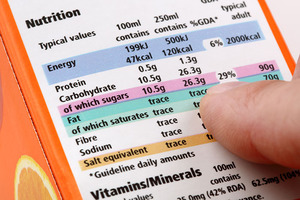A reliable source on many subjects.

A reliable source on many subjects.

![]()
 These days, the average adult consumes more sugar than they actually need. And thinking about reducing the amount of sugar consumed, or even adopting a sugar-free diet can be a good resolution for most people.
These days, the average adult consumes more sugar than they actually need. And thinking about reducing the amount of sugar consumed, or even adopting a sugar-free diet can be a good resolution for most people.
We can’t help but notice that this type of diet is gaining in popularity every day.
This is due to the fact that people have become more aware that keeping their health in good condition and maintaining a healthy weight is a matter of urgency.
This awareness stems from our contemporary lifestyle, which favours comfort, a sedentary lifestyle and laziness (little or no physical effort).
However, despite all its declared advantages, this diet should not be followed blindly.
In what follows, we have selected 8 practical tips for reducing your sugar intake without risk. But first, ….
 High sugar consumption has always been linked to an increased risk of various health complications such as diabetes and cardiovascular disease.
High sugar consumption has always been linked to an increased risk of various health complications such as diabetes and cardiovascular disease.
Most people consume more sugar than the average recommended by health experts.
These same experts estimate that a large proportion of this amount comes from added sugars [1].
In other words, unnatural sugars such as those found in fruit and vegetables.
Excessive sugar consumption can lead to numerous illnesses and health complications such as :
Reducing the amount consumed, or adopting a sugar-free diet altogether, can help reduce the risk of these diseases.
The idea is to replace fast or added sugars with healthy foods to provide the body with all the essential vitamins and minerals it needs, while promoting good health and weight loss too.
Here are eight simple tips we’ve selected to help you reduce or eliminate sugar from your daily diet:
One of the most important rules to follow when you’re about to make a change to your usual eating habits is to go slowly.
Don’t rush things, and avoid being brutal. Switching from a high-sugar diet to a sugar-free diet should be a gradual process.
Start by eliminating the most obvious sources of sugar. Baked products such as cakes, muffins and brownies can easily be eliminated first.
Eliminating sweets like candy and sugary drinks is also a great place to start.
Other easy habits to adopt at the start of your sugar-free diet include reducing the amount of cream you put in your coffee or tea.
The body adapts more easily and quickly to a gradual reduction.
 The labels on the products you buy usually contain a wealth of nutritional information.
The labels on the products you buy usually contain a wealth of nutritional information.
Being aware of the composition of each food will enable you to make better dietary decisions.
Once you’ve managed to eliminate the obvious sources of sugar from your regular diet, it’s time to move on to other sources of sugar.
A close look at labels will help you identify which products to eliminate.
The sugar contained in commercial products can have many names. It can also be present in different forms in the same product.
There are at least 61 different names for sugar on food labels.
The most common are :
As a general rule, all names ending with the suffix “-ose” refer to a type of sugar. Examples include sucrose, glucose, dextrose, fructose and lactose.
Given the large number of sugar names, reading a product’s label before consuming it is a necessary and compulsory step for anyone following a sugar-free diet or seeking to reduce the amount of sugar consumed per day.
Commonly consumed foods that contain sugar in their composition include salad dressings, condiments, pasta sauces, breakfast cereals, granola bars, etc.
Many dieticians recommend avoiding simple carbohydrates.
These carbohydrates are essentially sucrose, lactose and fructose. They are easily assimilated by the body and are described as fast sugars with a high glycemic index.
All the research undertaken confirms that this type of food is harmful to health and can cause numerous health complications such as obesity and cardiovascular disease.
And given that carbohydrates are essential to the body’s proper functioning, as they represent the body’s primary source of energy, it’s advisable to opt for complex carbohydrates, which are assimilated more slowly and therefore don’t cause blood sugar peaks.
These carbohydrates are generally found in unprocessed foods rich in fiber, vitamins and minerals, such as starchy foods, rice, cereals, vegetables, pulses, etc.
 Artificial sugars or sweeteners are the subject of much controversy in the food industry.
Artificial sugars or sweeteners are the subject of much controversy in the food industry.
It’s true that they taste sweeter than sugar itself and contain few or no calories.
However, consuming them fools the brain into thinking it is eating sugar. This can exacerbate a person’s sugar cravings.
If you want to succeed in your sugar-free diet, you need to avoid these artificial sugars.
Here’s a non-exhaustive list of sweeteners authorized (totally or with certain dosages) in France:
Sorbitol, Sorbitol syrup, Mannitol, Potassium acesulfate, Isomalt, Saccharin, Sodium saccharin, Calcium saccharin, Potassium saccharin, Sodium saccharin, Sucralose, Thaumatin, Glycyrrhizin, Neohesperidin DC, Stevia, Neotame, Salt of aspartame acesulfame, Tagatose, Maltito, Maltitol syrup, Lactitol, Xylitol.
At this stage, you can easily control the sources of sugar in processed foods, but what about drinks?
Beverages such as soda, coffee, sweetened tea and commercial fruit juices are a major source of fast sugars.
You can replace these drinks with unsweetened herbal teas, sugar-free coffee, sparkling mineral water or simply pure water.
This habit will help you stay hydrated while sticking to your sugar-free diet.
It’s an indisputable fact that whole foods are better than processed foods!
Processed foods are likely to contain refined ingredients or added sugars.
A diet based on whole foods should contain vegetables, fruit, lean meat, poultry, fish, whole unprocessed leguminous grains, nuts and seeds, etc.
For those of you who wish, you can add a small amount of dairy products to your diet plan, such as natural yogurts, plain cheeses or milk, …
A diet without a plan is difficult to maintain and therefore more likely to fail.
When you’re feeling peckish or a little hungry, it’s hard to hold back and the risk of ingesting unhealthy snacks becomes greater.
Many people have found a way to get organized by devoting a single day to doing their weekly shopping and preparing their meals for the whole week.
This way, when temptation arises, they’re less tempted to reach for a high-calorie chocolate bar or soda.
Planning your meals is a step that everyone hates, but it’s an essential step if you want to succeed with your sugar-free diet.
 Sugar isn’t the only condiment you need to add flavor to your dishes and drinks.
Sugar isn’t the only condiment you need to add flavor to your dishes and drinks.
Numerous species of sweet-tasting herbs and spices can easily be added to your daily food to replace the lack of sugar.
These natural alternatives to sugar include cinnamon, nutmeg, vanilla, etc.
These replacements can be added to your coffee or sprinkled on your yoghurt.
Whether it’s a sugar-free diet or just a reduction in the amount of sugar in your diet, there are many benefits, from clearer skin tone to the prevention of certain chronic diseases and complications.
Eliminating added sugars and maintaining a diet rich in whole (unprocessed) foods provides numerous benefits for the body, including:
Before embarking on a sugar-free diet, you should consider whether you want to eliminate natural sugars too.
These sugars are those found in fruit and some dairy products.
And while some followers of this type of diet stipulate that you should also do without fruit (and therefore the natural sugar it contains), we don’t think this is a good idea.
Fruit contains many nutrients, fibers, antioxidants and other healthy compounds that support healthy body function and help protect against disease.
Including whole fruits in your sugar-free diet is a healthy resolution as long as you eat them in moderation and without excess.
A final recommendation.
Anyone wishing to embark on a sugar-free diet should first speak to their doctor or nutritionist.
This recommendation is imperative for people suffering from a health problem or complication.
A sugar-free diet plan should be approached gradually.
Alternating between a sugar-free diet plan and eating sugar on special occasions can help some people overcome feelings of deprivation.
Reducing sugar is undoubtedly a good idea for everyone, as it helps reduce the risk of many conditions and can improve overall health.
However, eliminating sugar from the daily diet should not be seen as a sufficient solution to weight loss.
It should be seen as a complement to other lifestyle changes, such as regular exercise and a varied, nutritious diet.